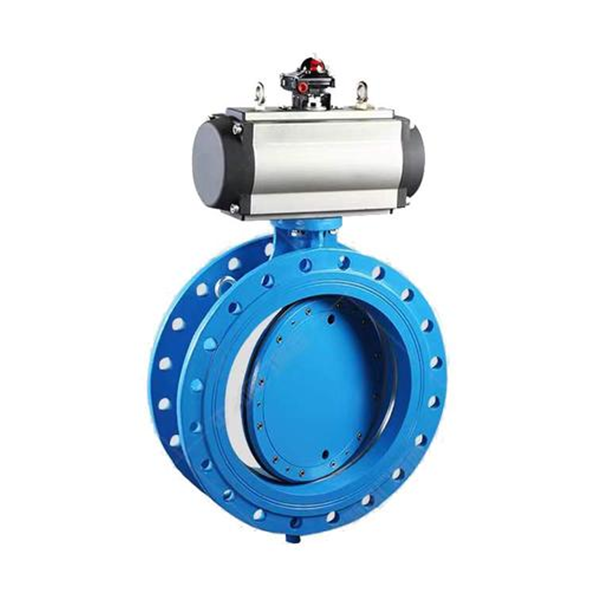Magpie Valve Selection: Accurate Matching Ensures Reliable Control
Valve Technology Sharing
Characteristics and Selection of Pneumatic Double-Eccentric Butterfly Valves: Sealing, Service Life and Eccentric Structure Comparison
The sealing surface of the valve disc is offset from its rotation center (radial eccentricity), allowing the disc to detach from the seat before rotating. This prevents the abrasive wear found in concentric butterfly valves, where the disc scrapes against the seat. Upon closing, the sealing surface gradually aligns via "line contact," forming an initial seal.
The rotation axis of the disc is offset from the valve body centerline (axial eccentricity). This enhances the opening and closing process: the disc moves axially away from the seat before rotating open, and during closing, it rotates into position and then axially compresses against the seat. This significantly reduces frictional resistance, typically 30–50% lower torque than concentric butterfly valves.

During closure, the disc initially contacts the seat via line contact, generating a sealing pressure ≥ 0.5 MPa. As actuator torque increases, the contact area expands into a surface seal, reaching sealing pressures of 1.5–2 MPa. This ensures reliable sealing under medium to high pressure conditions (standard: ≤1.6 MPa; high-pressure models: up to 2.5 MPa).
Seat materials include NBR (up to 120°C), FKM (up to 200°C), and metal seats (welded stainless alloy). Combined with the valve's low-friction design, this avoids premature wear common in concentric valves, extending rubber seat life from 1 year to 3–5 years, and metal seals to over 100,000 cycles.
|
Type |
Structural Features |
Torque |
Sealing Class |
Applications |
Cost (DN300) |
|
Single Eccentric |
Disc sealing surface offset; no axial offset |
Medium |
ANSI Class IV |
Low pressure & temperature (≤1.0 MPa, ≤80°C) |
Lowest (80% of double) |
|
Double Eccentric |
Radial + axial offset; "disengage then rotate" |
Low |
ANSI Class V (soft seal) |
Medium pressure/temp (1.6 MPa, ≤200°C) |
Medium (close to triple) |
|
Triple Eccentric |
Adds sealing face angle (3°–5°); metal-to-metal seal |
High |
ANSI Class VI (zero leakage) |
High temp/pressure, steam, oil services |
Highest (+10–15% over double) |
Key Differences Explained:
Torque Origin: Double-eccentric designs avoid radial friction during opening/closing due to axial offset, reducing the required torque (T = K × D² × P, with K 40% lower than concentric). Triple-eccentric valves require additional torque to overcome sealing surface compression caused by the angular offset.
Sealing Life: The low-friction sealing of double-eccentric valves prevents the wear-fatigue typical in single-eccentric/concentric types. Testing shows rubber-seated double-eccentric valves last over 5 years with 10 daily actuations; metal-sealed types exceed 200,000 cycles (triple-eccentric 150,000 due to greater seal friction).
Double eccentricity demands tight CNC machining tolerances (±0.05mm for radial, ±0.1mm for axial), and precision fit between disc and seat, verified via 3D coordinate measurement.
Even soft-seal seats require high-precision eccentric molds, with tooling costs 30% higher than concentric designs to avoid seal failure from misalignment.
To withstand medium-high pressure, valve wall thickness increases by 10–15% over single-eccentric models (e.g., DN300: 14mm vs. 12mm), raising material cost.
Although torque is lower, actuators are intentionally oversized (1 size above calculated) for long-term reliability, especially under fluctuating pressure conditions, raising actuator cost by 10%.
Medium-pressure pipelines: Natural gas (0.8–1.6 MPa), district heating water (1.0 MPa, 150°C), chemical solvents (e.g., ethanol, acetone with FKM seals), requiring both sealing and low torque.
High-frequency operation: Aeration valves in wastewater plants (50–100 cycles/day), food processing lines with hygienic-grade double-eccentric valves (Ra≤0.8μm, clamp connection), where longevity is critical.
Temperature-based Seal Material:
≤120°C: NBR for cost-effectiveness
120–200°C: FKM for heat resistance
200°C: Use triple-eccentric with metal seals, soft seals risk carbonization
Pressure & Size Considerations:
DN ≤ 200mm: Leverage torque advantage, use spring-return actuators for fail-safe design
DN > 300mm: Confirm torque with supplier-provided torque-pressure curves; e.g., DN400 at 1.6 MPa requires ≥200 N·m closing torque
Core Value = Sealing Performance × Service Life ÷ Cost
Although initial costs are close to triple-eccentric valves, the low-friction, long-life design significantly lowers long-term operational expenses, cutting valve replacements and energy use by over 40% compared to concentric or single-eccentric types. This makes them ideal for critical, continuous-process industries like power and chemical plants.
In summary:
Single-eccentric wins on price
Triple-eccentric wins on performance
Double-eccentric wins on balanced, long-term value
For customers seeking a cost-effective solution that delivers both sealing integrity and extended service life, double-eccentric butterfly valves are the optimal, well-rounded choice.